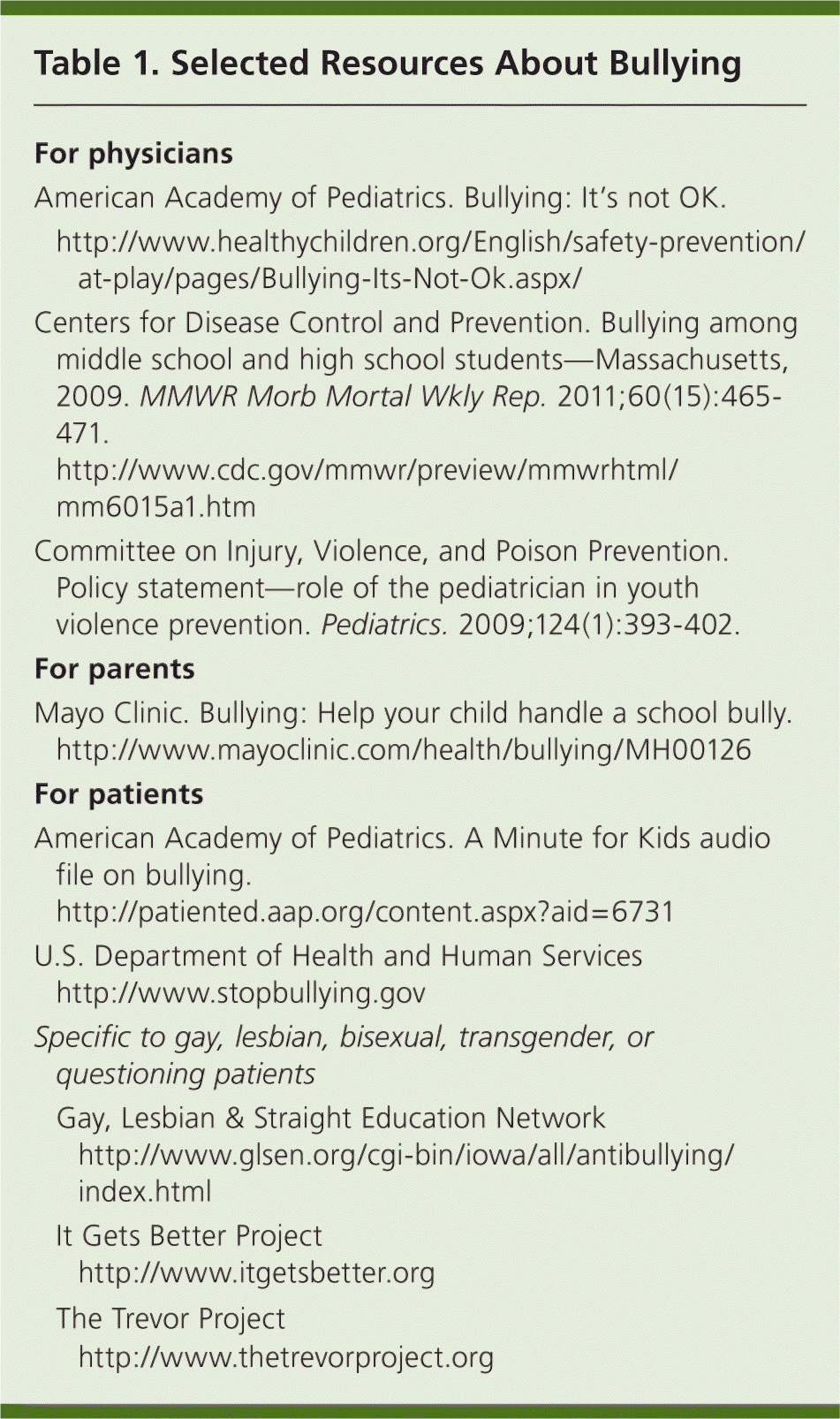
Am Fam Physician. 2013;88(2):87-92
Author disclosure: No relevant financial affiliations.
A previously healthy teenager was being treated in our clinic for depression. We thought it stemmed from his mother's disapproval of his recently revealed homosexuality, but after the mother-son conflict was resolved, his symptoms persisted. Only when bruises on his legs and chest were found did he finally disclose his true stressor: profound, long-standing bullying at school and online.
Bullying has received increasing attention in the past decade, perhaps because of acts of violence and suicide committed by persons who have been bullied. Studies show that bullying, typically characterized by an ongoing pattern of aggression in the context of an apparent power differential,1 is widespread. Each year, nearly one-third of Americans 12 to 18 years of age report being bullied at school,2–5 although only one in three of those who are bullied tells school authorities.3
The average U.S. adolescent now uses media about 10 hours per day.6 In addition to sexting, driving while texting, Internet addiction, and Facebook depression, cyberbullying has emerged as an associated problem. The unsupervised and anonymous forms of some media may reduce inhibition to bullying.4,6,7 Overall, 10% to 35% of adolescents say they have been cyberbullied, including through text messages, Internet postings, e-mail, instant messages, online gaming, and exclusion from online communities.3,6
Persons who bully and those who are bullied have consistently been found to have higher levels of depression, suicidal ideation, physical injury, distractibility, somatic problems, anxiety, poor self-esteem, and school absenteeism than those not involved with bullying.2,5,8–12 One study found that more than one-half of children who deliberately harmed themselves had been bullied, and that those most often bullied were most likely to inflict self-harm (independent of IQ, environmental risk factors, and preexisting emotional problems).12 Furthermore, those who both bully others and are themselves bullied experience the highest rates of suicidal behavior, social problems, and poor emotional outcomes.2,9,10
Bullying of gay, lesbian, bisexual, transgender, and questioning youth is particularly noteworthy. These youth have high rates of depression, suicidal ideation, compromised school belonging, and sexually transmitted infection in young adulthood.13,14 One large statewide study found that gay, lesbian, and bisexual youth were significantly more likely to experience peer violence than were heterosexual youth (56% vs. 28% within the previous month), as well as significantly more likely to attempt suicide (21.5% vs. 4.2% within the previous 12 months). Their likelihood of attempting suicide was 20% higher when in an environment unsupportive of their sexual identity.11
Patients of primary care physicians should undergo psychosocial screening as part of routine wellness visits and when seeking care for mental health or somatic problems, or behavioral concerns.1 Physicians should be alert to any indications of bullying and identify relevant sequelae in a full psychosocial evaluation, such as the HEEADSSS assessment (in which the patient is asked about home life, education/employment, eating habits, activities, drug and alcohol use, sexuality, personal safety, and suicidal ideation/depression).15 Open-ended questions may provide adolescents a comfortable opportunity to discuss their experiences. For example, “Some teens have told me about feeling bullied or picked on at school or online. What has happened with you or your friends?”
Physicians should also recognize that a patient's hesitancy to use or converse about electronic media may be evidence of undisclosed cyberbullying.6 They should educate parents about the phenomenon and empower them to supervise their children, to discuss cyberbullying, and to set limits on their children's media use.6
Patients identified as being at high risk of engaging in or experiencing bullying should be screened for psychiatric disorders, including depression, and follow-up visits should be arranged.1 Using motivational interviewing to build on a patient's strengths, the physician can foster patient-originated solutions. Interactions with respected and compassionate adults and involvement in peer social groups and after-school programs can help to improve social support and build resiliency.16,17 Table 1 provides a list of resources about bullying.

| For physicians | |
| American Academy of Pediatrics. Bullying: It's not OK. | |
| http://www.healthychildren.org/English/safety-prevention/at-play/pages/Bullying-Its-Not-Ok.aspx/ | |
| Centers for Disease Control and Prevention. Bullying among middle school and high school students—Massachusetts, 2009. MMWR Morb Mortal Wkly Rep. 2011;60(15):465–471. | |
| http://www.cdc.gov/mmwr/preview/mmwrhtml/mm6015a1.htm | |
| Committee on Injury, Violence, and Poison Prevention. Policy statement—role of the pediatrician in youth violence prevention. Pediatrics. 2009;124(1):393–402. | |
| For parents | |
| Mayo Clinic. Bullying: Help your child handle a school bully. | |
| http://www.mayoclinic.com/health/bullying/MH00126 | |
| For patients | |
| American Academy of Pediatrics. A Minute for Kids audio file on bullying. | |
| http://patiented.aap.org/content.aspx?aid=6731 | |
| U.S. Department of Health and Human Services | |
| http://www.stopbullying.gov | |
| Specific to gay, lesbian, bisexual, transgender, or questioning patients | |
| Gay, Lesbian & Straight Education Network | |
| http://www.glsen.org/ | |
| It Gets Better Project | |
| http://www.itgetsbetter.org | |
| The Trevor Project | |
| http://www.thetrevorproject.org | |
Patients demonstrating significant morbidity should be screened for suicidal ideation and risk factors for violence (e.g., gang participation, access to weapons), given a safety plan, and treated for any psychological comorbidities.1,16,17 Even multiple environmental risk factors for the perpetration of violence can be mitigated if the parents maintain connectedness with the child and set clear expectations regarding their child's behavior, scholastic performance, and value system.16
On a broader level, physicians can improve primary prevention by advocating in school and community settings for the use of evidence-based strategies that restrict the social environment, encourage bystander intervention, and improve social-emotional learning.10 By joining the fight against bullying at both the individual and societal levels, physicians can prevent needless suffering and deaths.
